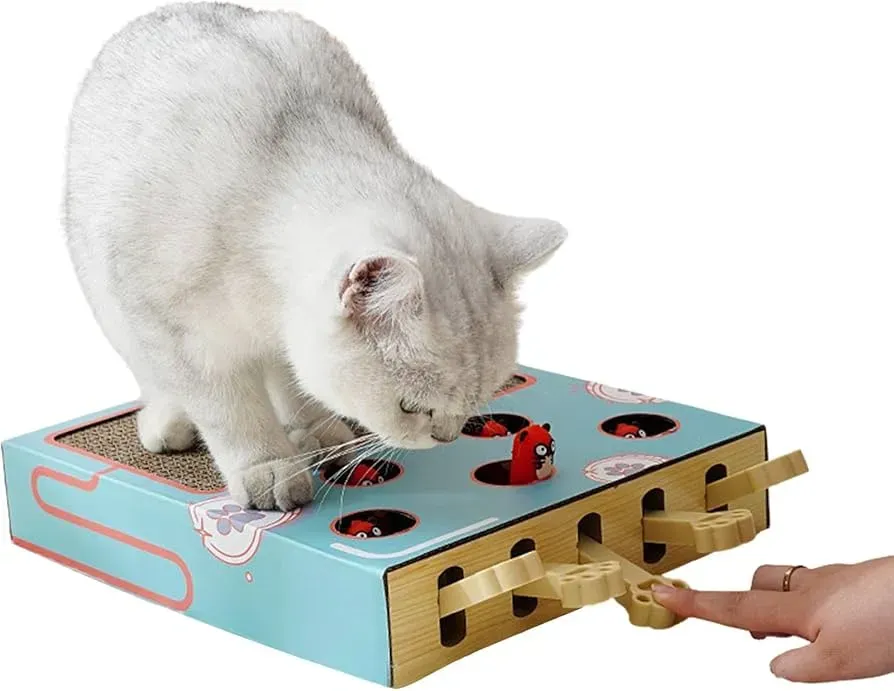Table of Contents
Ever find yourself staring down the barrel of a cat's wide, predatory eyes, right before they launch themselves at something you value? Or perhaps you've experienced the joy of a feline ninja attack on your unsuspecting ankles at 3 AM? Look, it's not personal. Your cat isn't plotting your demise (probably). What you're witnessing is the hardwired, non-negotiable instinct of a predator. Domestic cats retain that powerful drive to stalk, chase, and pounce, even if their biggest hunt involves a dust bunny under the sofa.
Why Your Cat Needs to Hunt (It's Not Optional)

Why Your Cat Needs to Hunt (It's Not Optional)
Instinct Runs Deep, Even for Couch Potatoes
Let's be real: your adorable fluffball, currently napping in a sunbeam, is a tiny, highly efficient predator. It doesn't matter if their ancestors stalked the plains of Africa or the alleys of Brooklyn; the programming is still there. Hunting isn't some cute hobby for cats; it's a fundamental behavioral need. They are hardwired to detect, stalk, chase, capture, and consume prey. It’s a complex sequence, a whole production, and skipping any part of it leaves them feeling… incomplete. Think of it like needing to finish a good book – leaving it halfway through just feels wrong.
This isn't just about getting exercise, although that's a nice bonus. The hunt engages their brain in ways batting a ball around an empty room simply can't. It requires focus, problem-solving, patience, and bursts of intense energy. When they can't express this natural behavior, that energy and instinct don't just vanish into thin air. They find other outlets, and trust me, you probably won't like them. Your furniture, your toes, your sanity – these can become unintended targets.
What Happens When the Hunter Can't Hunt?
Imagine being built to run marathons but being told you can only walk around your living room. Frustrating, right? That's a bit like a cat with a suppressed hunting drive. When they don't have appropriate outlets for this instinct, you start seeing issues. We're talking stress, anxiety, destructive scratching (that sofa looks suspiciously like a tree trunk), aggression towards people or other pets, and even obsessive behaviors like overgrooming. It's like a pressure cooker building steam; eventually, something's got to give.
Providing opportunities for simulated hunting isn't spoiling your cat; it's meeting a basic welfare need. It channels that powerful predatory energy into positive activities. A cat that gets to "hunt" regularly is generally a calmer, happier, and better-adjusted animal. They've satisfied that primal urge, and they're less likely to invent their own, less desirable, games. It’s about respecting their nature, not trying to pretend they're just furry, purring ornaments.
- Cats are obligate carnivores and natural predators.
- The hunting sequence (stalk, chase, capture, consume) is instinctual.
- Suppressed hunting leads to stress and behavioral problems.
- Simulated hunting provides mental and physical stimulation.
- Satisfied hunters are generally calmer cats.
Decoding the Best Interactive Cat Hunting Toy Types

Decoding the Best Interactive Cat Hunting Toy Types
so we know they need to hunt, and a sad, neglected plush mouse under the fridge isn't cutting it. The market is flooded with things claiming to be an. Some are brilliant, some are… well, let's just say they're probably more entertaining for the human briefly before the cat loses interest. The key is finding toys that actually tap into that specific hunting sequence: the stalk, the chase, the capture. These aren't just passive objects; they require your participation or are designed to simulate unpredictable prey behavior. We're talking about things that dart, wiggle, hide, and generally act like something a cat would naturally pursue.
Mastering Playtime with Interactive Cat Hunting Toys
Become the Wiggle: How to Play Effectively
you've got your shiny new. Now what? Don't just dangle it in their face like a bored parent with car keys. The magic happens when you make the toy act like actual prey. Think small, quick movements. Hide it around corners, under rugs, behind furniture. Let it dart out, pause, and then zip away. This mimics the erratic, unpredictable nature of a mouse or bird.
Resist the urge to wave it constantly in their face or move it too fast. That just frustrates them. Allow them to stalk. Let them hide. Build the tension. A good hunting session involves anticipation as much as action. Your hand is just the puppet master; the toy is the star, and it needs to perform a believable role as something trying to escape capture. This isn't about tiring them out; it's about engaging their natural sequence of behaviors.
The Grand Finale: The Capture and 'Kill'
A crucial, often overlooked part of using anis the ending. Cats don't just chase forever; they aim to capture and 'kill'. After a good chase, you need to let them catch the toy. Let them grab it, bunny-kick it, and feel like they've successfully completed the hunt. Don't yank it away the second they grab it; that's like snatching the trophy just as they cross the finish line. It's incredibly frustrating and teaches them that capturing is pointless.
Once they've "killed" it (usually involves some vigorous chewing or bunny-kicking), leave the toy with them for a moment. This simulates the consumption phase. Some experts even recommend immediately giving them a small, high-value treat after the play session ends. This links the successful hunt to the reward, completing the entire predatory sequence from stalk to consumption. Aim for several short sessions a day (5-15 minutes each) rather than one long, exhausting one. Cats hunt in short bursts.
Key Playtime Principles:
- Mimic prey behavior: unpredictable darts, pauses, hiding.
- Allow stalking and hiding; build anticipation.
- Let your cat *capture* the toy at the end of the session.
- Allow a brief "kill" phase (chewing, bunny-kicking).
- Consider a small treat immediately after capture.
- Keep sessions short (5-15 minutes) and frequent.
- Rotate toys to keep things fresh and interesting.
Real Benefits of Interactive Hunting Play for Your Cat

Real Benefits of Interactive Hunting Play for Your Cat
Boosting Physical Fitness and Preventing the Pudding-Cat Syndrome
Let's face it, many indoor cats live a pretty sedentary life. Their biggest physical challenge might be the leap onto the highest bookshelf. While naps are crucial, a lack of activity leads to the same issues humans face: weight gain, muscle loss, and joint problems. Anforces your cat off the couch. It makes them run, jump, stalk, and pounce – the very movements their bodies are designed for. Regular interactive play sessions burn calories, build lean muscle, and improve coordination. It's their cardio, their strength training, and their agility drill all rolled into one. Forget expensive cat gyms; a well-used wand toy is often far more effective at keeping them in fighting shape, preventing them from turning into a furry, unhealthy blob.
Sharpening Minds and Calming Chaos
Beyond the physical, the mental stimulation from using anis immense. Hunting isn't just a physical act; it's a complex cognitive task. Cats have to assess the "prey's" movements, plan their stalk, anticipate direction changes, and calculate the perfect pounce. This problem-solving and focus are crucial for mental well-being. A bored cat is a stressed cat, and stress manifests in various charming ways, like destroying your favorite rug or picking fights with their housemates. Engaging their predatory brain tires them out mentally, reducing anxiety and channeling that pent-up energy into positive activity. It's like giving their brain a workout that leaves them feeling satisfied and less inclined to invent their own, less desirable, forms of entertainment.
Key Benefits of Interactive Hunting Play:
- Promotes healthy weight and muscle tone.
- Improves coordination and agility.
- Provides crucial mental stimulation.
- Reduces stress, anxiety, and boredom.
- Decreases likelihood of destructive behaviors.
- Satisfies natural hunting instincts.
- Strengthens the bond between you and your cat.
Building Bonds and Speaking Cat
Playing with anisn't just about the cat; it's a powerful way to connect with your feline friend. When you're the one controlling the "prey," you become part of the hunt. You're engaging with them on a deeply instinctual level, communicating in a language they truly understand. These shared hunting sessions build trust and strengthen your bond. It's dedicated quality time that reinforces positive interactions and helps your cat see you not just as the food dispenser, but as a partner in their most important activity. Successfully completing a "hunt" together creates a shared positive experience, fostering a sense of security and connection that passive toys simply can't replicate.
Making the Hunt Happen (For Everyone's Sanity)
So, there you have it. That instinct to chase, pounce, and "kill" isn't just a cute quirk; it's a fundamental part of what makes your cat a cat. Ignoring it is like telling a fish not to swim. Providing the rightisn't a luxury; it's essential enrichment. It keeps their minds sharp, their bodies moving, and frankly, saves your furniture (and potentially your limbs) from becoming surrogate prey. Don't just toss a toy and walk away; become part of the hunt, mimicking the unpredictable movements of real prey. A little effort in facilitating their natural behavior goes a long way toward a happier, healthier cat and a more peaceful coexistence. It's not rocket science, just good cat sense.